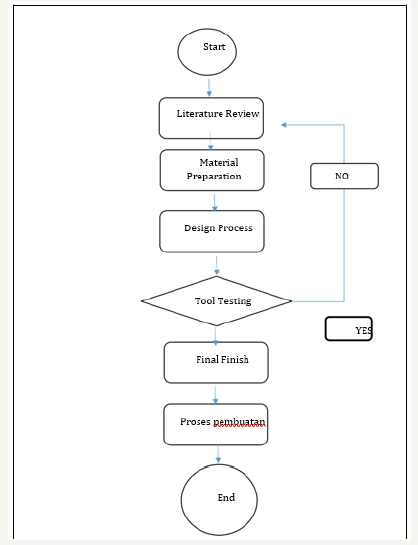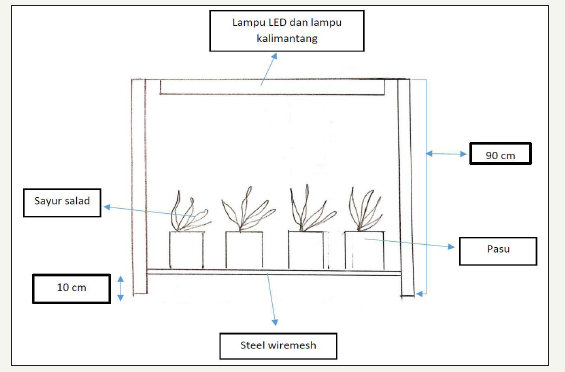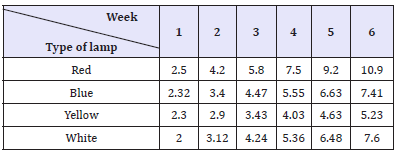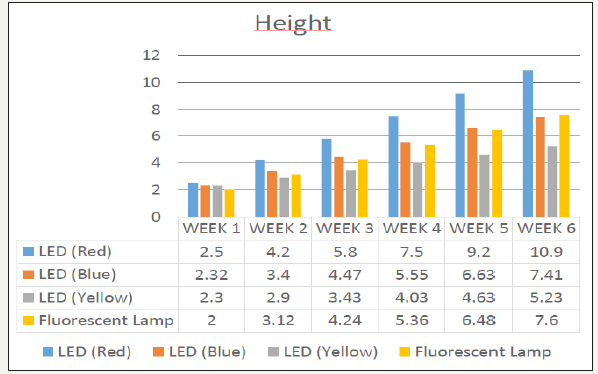- Submissions

Full Text
COJ Electronics & Communications
Investigation on Vegetable Growth Using Artificial Sunlight for Indoor Farming
Mu Azzrol B Manohar, Mohd Sharizan B Mokhtar, Ahmad Nizam B Mohd Jihan, Nur Azlyeza Bt Rahman and Kesavan Ulagnathen*
Politeknik Sandakan Sabah, Malaysia
*Corresponding author: Kesavan Ulagnathen, Politeknik Sandakan Sabah, Malaysia/p>
Submission: October 01, 2018;Published: November 14, 2018

ISSN 2640-9739 Volume1 Issue4
Abstract
Indoor planting or better known as indoor farming has become more widely used method as it is able to provide higher yields throughout the year. Currently most of the developed country the shortage of land for agriculture and the time is a major factor effecting agriculture sector, it is a global trend. In this technique, one of the most important things is the use of artificial light sources to replace the sun at indoor environment. Although there is still no such light that capable of replacing the sun completely, but sometimes the artificial light provides better results. The use of artificial light in plant cultivation was first began in 1868 by a Russian botanist Andrei Famintsyn. The use of artificial light changes according to current technology from time to time. The results of previous studies showed similar outcome that were relied on the capabilities of existing equipment at that time. In this study, three different LED color lights, 18W and a fluorescent lamp, 36W were used. The height or growth of the salad plant was taken for 6 weeks period. At the end of the study, the height of the salad plant in the red LED lamp is as high as 10.9cm, followed by the Blue, White and Yellow Lights, 7.41cm, 7.6cm and 5.23cm. From the studies it shows different color lights create an impact on the height growth of a plant or vegetable. This study is useful for researchers that focus on indoor farming using artificial light as a source of sunlight.
Keywords: In door farming; LED lamp; Fluorescent lamp; Height
Introduction
Light is one of important parts of plant life, because the precise plants contain 45% of dry weight which consists of carbon derived from the air. In this case, photosynthesis carbon assimilation process occurs only with the inclusion of light on the rate of photosynthesis that influenced by many external factors, but most importantly - is the similar light intensity. Light may be the most important condition for the growth of normal plant with proper lighting. Unlike incandescent lamps, fluorescent lamps are almost giving off less heat, so it would not affect room temperature, thus it is more suitable to illuminate the plants. They have high luminous efficacy even though over time it tends to decline, but still they are relatively cheap and low energy consumption [1].
Generally, the wide use of fluorescent fittings has been a popular option for all types of building premises whether residential, office, shopping malls and so on. Among other things, the fluorescent lamps are very popular because it produces white bright light without causing glare, cheap, easy to get at any home and electrical stores (Abdul Aziz, 2014). The LED light produces the lowest heat thus it reduces the release of carbon dioxide into environment. Its usage can reduce the rate of global warming by 50 percent over time. The light or LED light diode is a semiconductor diode that produces a non-coherent narrow-spectral light when electrically charged voltage is passed through the p-n junction. The principle is known as electroluminezation. LEDs are produced in various types of light colors, depending on the type of semiconductor used Abdul Khalid Mydin 2009.
Various types of lamps with different types of light have been produced by industry and they have been applied in indoor plants but have not been known to be suitable for the use in plant growth. This study is focused on introducing a light source other than source from the sunlight and creating artificial light in indoor space by distinguishing between fluorescent lamps with LED light (LED light emitting diode) towards vegetable salad growth that consists of white color for fluorescent lamps while red, blue and green colors for LED lamps. Thus, this study was conducted in an enclosed room without any access to light. Light color possesses a role in photosynthesis as chlorophyll will use specific light colors i.e. blue spectrum and red spectrum [2-4
Problem Statement
The community has no land and space for cultivation in a farm due to the limited area available for cultivation purposes. Hence, this innovation would enable people to implement home cultivation without the need to engage with farm cultivation.
Objective
a. To identify the influence of different light shades and plant growth performance according to different light sources towards plant growth.
b. To provide an innovative indoor plant design that allows people to grow plants without sunlight.
Scope
a. Green technology
The innovative study is focused on learning how the growth of indoor salad can be affected by artificial light sources such as fluorescent lamps and LED lamps.
b. Modern agriculture
Designing a plant that based on ‘indoor plant’ concept to facilitate community in farming even though it has to be done on premises
c. Environmental control
The differences of crop conditions with different sources of light on the growth of salad vegetables (Latuva Sativa)
Methodology
The implementation of this study is one of the study’s agenda that needs to be done to facilitate the works of this study and the objectives that have been given [5,6]. In addition, the implementation of the study can provide an overview of project trips that is undertaken before the next stage. This study will be conducted at Polytechnic Sandakan Sabah as it is an ideal location for this project. The study was conducted in a closed and confined room so that the different sources of light would not penetrate one to another to avoid lights mixing issue except for fluorescent lamps and LED lamps (red, blue and green) in order to facilitate data analysis on salad vegetable growth [7]. The shelves and walls are assembled to cover all parts so that light would not be able to penetrate it from outside of the room. Aluminium is used as a barrier or wall on each shelf so that the light is blocked completely.
There are different types of lamps installed such as fluorescent lamps and LED lamps (red, blue, and yellow). Each LED lamp uses 18 watts while fluorescent lamp is 36 watts. In addition, the distance between the light source and the plant is 60cm. The fluorescent lamps and LED lamps work automatically for 18 hours and 1 lamp is put on each shelf. Transplanting cultivation technique is chosen as a planting method for the suitable peat moss medium which is filled in the pots. This technique is used to obtain different data analysis from the beginning until the end of planting. This study uses peat moss as cultivation media. This type of medium can store water and would not dry easily. Thus, it would be able to moisten the soil for the benefit of the plants. Figure 1 is the flowchart that refers to implementation of the study while Figure 2 is the diagram that refers to the structure of the study [8,9].
Figure 1:Implementation of study.

Figure 2:Research structure.

Analysis and Discussion
From the findings of the study, it was found that the plants that were grown with the light sources from fluorescent and LED lamps were able to grow and flourish excellently. This research has a purpose to know the effects of LED lamps and fluorescent lamps on salad growth to achieve optimum growth in the ‘indoor plant’. After fertilization, the growth of salad was immense. In a week, the salad growth was increased by 1.23cm. Meanwhile, through the observation that was conducted on the sixth week, the growth rate of the plant that was illuminated in red coloured LED lamps was better than other lamps. Table 1 and Figure 3 illustrate the height of salad growth for a period of six weeks according to different types of light sources.
Table 1:Salad height (cm) by types of light sources.

Figure 3:Height of salad growth according to the different types of light sources.

Further analysis was carried out using the velocity of light, wave length and frequency formula to justify the findings. Known,
c=λf ------- (1)
f=c/λ ------- (2)
From equation (2), we can assume when the, λ (wave length) id increasing the frequency will be decreasing and vice versa.
Where by,
c=Velocity of light in vacuum, λ=Wave length and f=Operating frequency, λred=700nm, λblue=500nm, λyellow=590nm
From this point of view, by analysing the data, it shown lower frequency radiation contribute to the more growth of a vegetable. In another word lower frequency radiation, longer the growth of a vegetables and if higher frequency radiation, shorter the growth of a vegetables.
Conclusion
This study can be beneficial to people and society based from the amazing results and it has many potentials for further research in the future. First of all, this study could help people who could not find the right time and place for farming activities, especially vegetables planting that require sunlight to grow. Furthermore, this study is one of the alternatives for community to carry out planting activities at home or workplace because the materials and equipment used are readily available in the market nowadays. Additionally, the project can also be commercially marketed for the use in agricultural industries or agricultural-related activities that do not have large area for cultivation. Overall, the objective of the study is met which is producing salad planting techniques by using LED lamps and fluorescent lamps as light sources without the use of sunlight. Therefore, from this study the concept of ‘Indoor Planting’ can be materialized.
Acknowledgement
We would like to thank personally Agro technology Department of Polytechnic Sandakan Sabah for giving us an opportunity to conduct this study. Besides this our personal thanks to Mr Julainus Jiun from General Studies Department Polytechnic Sandakan Sabah for helping us on translation on the manuscript.
References
- Fajariyanti (2013) Pengaruh spectrum cahaya tampak terhadap laju fotosintesis tanman air Hydrilla verticillata. Prosiding Seminar Nasional Biologi 10(2): 1-9.
- Wicaksono (2014) Pengaruh pemberian spectrum cahaya berbeda terhadap kandungan klorofil.
- Reni R, Triyono S, Yusi A, Zahab R (2015) The effect of lamp types on the growth and production on lettuce grown in an indoor hydroponic system. Jurnal Teknik Pertanian Lampung 4(3): 219-226.
- Akhmad SP (2018) Ciri-ciri,klasifikasi, manfaat, syarat tumbuh dan morfologi tanaman selada Fikri Mastor. Manfaat Peat-Moss Pada Tanaman, Kebiasaan Dalam Amalan Tanaman.
- Joseph KJ (2006) Thailand: From investment-led growth to innovation- LED growth. Information Technology, Innovation System and Trade Regime in Developing Countries 53-85.
- Mitra A (2015) Industry-Led Growth: Issues and Facts. Industry-Led Growth Springer Briefs in Economics pp.1-67.
- Syafriyudin, Ledhe T (2015) Analisis pertumbuhan tanaman krisan pada warna cahaya lampu LED. Jurusan teknikel ektro fakultas teknologi industry institute sains dan teknologi yogyyakarta 8(1): 83-87.
- Lindawati Y (2015) The effect of lamp types on the growth and production of lettuce grown in an indoor hydrophonic system. Jurnal teknik pertanian lampung 4: 191-200.
- William GH, Norman P, Huner A (2008) Introduction plant physiology. The University of Western Ontario, Canada.
© 2018 Kesavan Ulagnathen. This is an open access article distributed under the terms of the Creative Commons Attribution License , which permits unrestricted use, distribution, and build upon your work non-commercially.
 a Creative Commons Attribution 4.0 International License. Based on a work at www.crimsonpublishers.com.
Best viewed in
a Creative Commons Attribution 4.0 International License. Based on a work at www.crimsonpublishers.com.
Best viewed in 







.jpg)






























 Editorial Board Registrations
Editorial Board Registrations Submit your Article
Submit your Article Refer a Friend
Refer a Friend Advertise With Us
Advertise With Us
.jpg)






.jpg)














.bmp)
.jpg)
.png)
.jpg)










.jpg)






.png)

.png)



.png)






